Content
We have had a dacha since 2003, but we only started the first steps on the path of transformation from a land user to agriculture in 2013.In the winter of 2013, I accidentally went to the site on natural agriculture, read the articles, listened to all the video lectures during the winter and there was a "reset" in my worldview. Every year I am more and more convinced that everything on our planet is connected together. Land, plants, animals, people. Now I have ceased to see in every weed, in every insect an enemy that is destroying my crop, for that matter, they are the true masters on Earth, and we need to learn to live with them in peace and harmony.
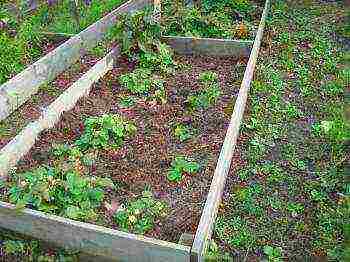
Any road starts with the first step. Trite but true. Every year I increasingly use the techniques and agricultural techniques of natural farming in my garden. The first thing we decided was not to dig, not to plow. The understanding has come that the heavy physical activity of soil cultivation must be shifted from humans to the natural inhabitants of nature, worms, frogs, lizards, bugs, green manure, and effective microorganisms. After turning over the layer, we at one moment change places of aerobic and anaerobic bacteria, destroy the structure of the soil and raise weed seeds from the depths to the surface.
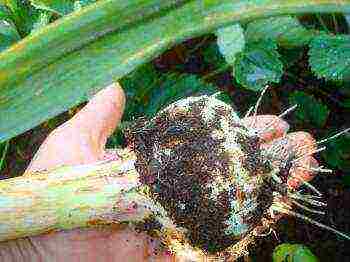
Indeed, after digging, the soil becomes looser, but this is before the first rain or watering. Loose soil is saturated with water and "earthy dough" is obtained. When dry, such a mixture becomes covered with a crust and cracks, it does not breathe and does not accumulate dew, and therefore throughout the summer there was a need for additional work to loosen the soil.
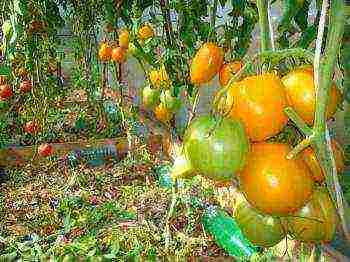
Now, in my understanding, well-groomed beds are not bare land without a single blade of grass, but land inhabited by worms, covered with mulch, protected from water washout, winds, cold weather, where plants exist in harmony with each other. This simple technique makes work easier and creates necessary conditions for good development of the root system. A well-developed root system provides excellent nutrition for plants and their rapid development.
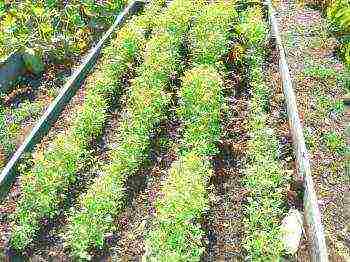
The second step is mulching, covering the soil with any organic matter that worms, fungi and microorganisms can eat, mixed planting, and the magical power of green manure, which loosen and structure the soil with their roots, was understood later. In the forest, the earth is covered with a thick layer of leaves, grass, cones, branches, this is what happens in nature, these are its laws, and the laws of nature are the same for all plants, regardless of where they grow. In the first year I was delighted with the result of mulching tomatoes and cucumbers, especially in a heifer.
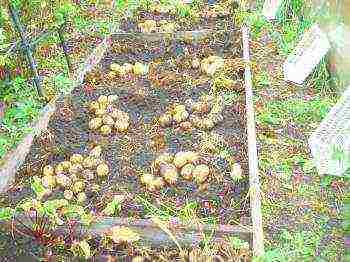
In the middle of summer, the soil temperature under the mulch was 10 ° C lower than the air temperature; worms and other inhabitants of soil formation willingly live here. I tried to regularly carry out root and foliar feeding with bio-cocktail and bionastoy with "Shining 1". Mulching is one of the ways to introduce organic matter into the soil and form humus.
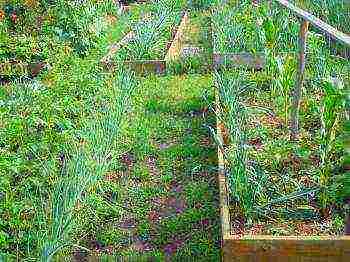
When mulch is processed by microorganisms, carbon dioxide is released, which is the main food for the plants. This soil temperature is very comfortable for root growth. And the humidity is more stable, they began to water twice less often.Now I am very sad to see the black, not mulched (not a speck) land from friends and neighbors, I want to "cover the land with a blanket" from the heat and cold. The main problem with mulching is that there is always little of it; next year we plan to purchase straw, including for conducting an experiment on planting potatoes under straw.
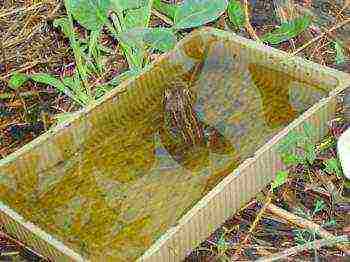
Our garden is located with a slope to the north, in the spring and in the rain, the water rolled down a hill into the lowland of the garden.
We divided the entire vegetable garden (including greenhouses) into stationary beds with wide aisles and immediately felt the advantages and convenience in work:
- melt and rainwater remains in the porous soil in the beds, and mulch delays the evaporation process;
-
no need to plan the beds annually, it is enough to do it thoughtfully once;
-
the cultivated area is significantly reduced: only the beds are cultivated, and not the entire area;
-
thanks to the paths that have appeared, the beds remain not trampled;
-
on stationary beds, you can install a permanent trellis, make a roof from the rain (so that diseases do not spread in drops on plants).
-
watering and introduction of nutrients is carried out in the beds, which is more rational.
-
and finally it is beautiful
During the winter, I plan and draw up planting schemes taking into account
crop rotation and plant compatibility
- a very exciting experience! Confident possession of a computer helps me in this, which stores all the information for the summer season and the plan for the next year.

The third step is sowing green manure, which is an integral part of the agricultural technology of natural farming. Green manure improves the structure of the soil, heals and enriches it with organic matter and nutrients. I use the green mass of siderates as mulch, as well as for preparing herbal infusions and repelling pests. I sow siderates from spring to autumn, guided by the basic rules that I have learned in natural farming. For example, before planting seedlings of pepper, tomatoes, eggplant, it is useful to sow white mustard, I sow it after harvesting garlic, after potatoes I sow rye. The most popular and favorite plants are protectors, without which it is impossible to imagine a garden and vegetable garden - these are marigolds, calendula, mint, parsley, onions, garlic, celery. They help to cope with uninvited guests - pests.
I sow siderata densely and cut it off before or during flowering so that they do not become weeds. Then I process the cut green mass with the "Radiance" microbiological preparations to accelerate the process of organic decomposition and recovery. I follow the rules of crop rotation: cultivated plants and green manure - the predecessors must be from different botanical families. Everyone knows that onions and carrots are the best friends in the garden. One crop repels pests of another and vice versa. After sprouting carrots, I plant onion seedlings in the gaps found. On a potato bed in the aisle, I plant cabbage, celery and onions, cucumbers with corn, tomatoes with basil. In autumn, after harvesting potatoes, I sow rye, which quickly turns the earth into a green carpet, as if spring had come. Rye protects the soil from the washing out of nutrients, serves as a refuge for hibernating beneficial insects. It loosens the soil with its roots better than a shovel, enriches it with organic matter, which replaces manure. Weeds are afraid of it like fire (even wheatgrass recedes), and it also cleans the soil from pathogens, including late blight. In the spring I cut the rye with a hoe, cutting it 5 cm below the soil and immediately spill it with the "Shining-1" preparation.
The fourth is plant nutrition. I was convinced that the use of preparations in the form of "Bio-cocktail for plants" and "Bionastoy" is very effective. In two greenhouses, barrels were placed, in which from spring to late autumn, bionasta is constantly prepared, a recipe that I learned from newspapers and video lectures on natural farming. Every housewife knows that cooking produces a lot of organic waste. But they can not be thrown away, but rationally used as fertilizer on your site. In winter, I have to save them and take them out into trenches prepared in the fall in greenhouses, in summer I put the plant waste under the plant, and mulch it on top with grass and process it with useful microorganisms.
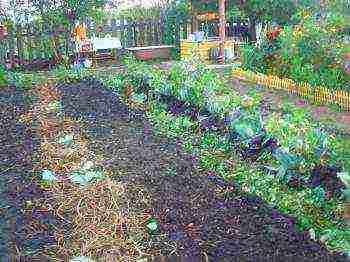
In the spring of 2016, two organic trenches ("Rozum's beds") were laid, and I learned about this agrotechnical technique in winter. The procedure is simple: first, the marking, then we dig a trench on a bayonet and fold the earth next to it, make the edges of the beds flat. After leveling the edges, lay tree branches at the very bottom of the trench, thicker ones - at the very bottom, thinner branches go higher. This year, in the spring, they thinned out the old irga, there were enough branches. Then we lay a layer of grass, foliage, any other organic matter on the branches. Each layer was sprinkled with effective microorganisms "Shining 2". This year, thanks to the agricultural technology of natural farming, with minimal costs, we received a very good harvest of vegetables and fruits.
I liked it very much, the main thing is that such a bed has been working for more than one year, all organic waste, cut branches of trees, weeds, potato peels are processed by soil bacteria and earthworms, and all this organic matter is immediately assimilated by plants. Organic waste decomposes very slowly in natural conditions. From video lectures on natural agriculture I learned (in practice this was confirmed) about the benefits of effective microorganisms:
-
increase the productivity of agricultural crops;
-
do not harm the environment;
-
effectively restore soil fertility by processing organic matter, which leads to an increase in the amount of nutrients that are readily available to plants;
-
inhibit the reproduction of harmful microorganisms, protect germinating seeds and plants from diseases;
-
promote the cultivation of biologically pure agricultural products;
-
earlier, the awakening of the soil and the restoration of its fertility occurs.

The fifth is mixed planting and crop rotation. Saving space in the beds, protecting plants with other plants, favorable conditions for the development of planting material can be achieved by placing several types of plants in the garden. It is only necessary to know certain rules for mixed planting of vegetables in the garden, so that the plants help each other. the same chemical compounds, pests and diseases of these garden crops accumulate in the soil. Natural crop rotation is a natural way to maintain soil fertility without large cash costs and without the use of chemical fertilizers. Reasonable crop rotation helps maintain soil fertility and plant health. The relationship of plants occurs when they are jointly placed on the same bed, or a neighboring one, as well as indirect influence through the soil on which the previous ones were grown. I found the answers to all these questions in lectures and articles on sites on natural farming. Now carrots in the garden always coexist with onions, potatoes with cabbage and onions, marigolds are welcome guests in cabbage, basil is in a tomato greenhouse and in a rose garden.
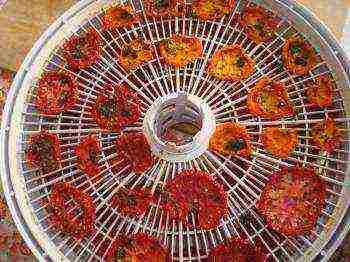
The Isidri dryer is what you need for processing crops for the long Trans-Ural winter. The Isidri dryer is our helper, it meets the highest international quality standards! Now I dry mushrooms, zucchini, eggplants, tomatoes, marshmallows from cherries, apples, strawberries (garden and forest), carrots, onions on it. I learned the recipes for preparing delicious dishes from the newspaper thanks to subscription to new articles, a very convenient and affordable way to get up-to-date information on agrotechnics of natural farming.
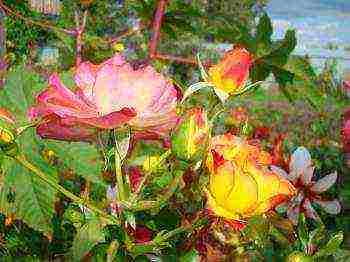
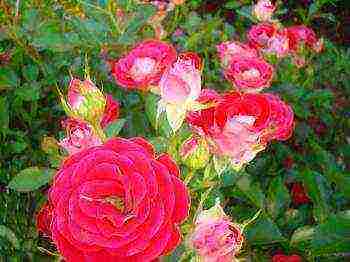
And of course, she discovered the world of incomparable roses for herself. Thanks to the lectures of the center natural farming on the agricultural technology of growing roses in the Trans-Urals, this queen of flowers took possession of my heart completely and forever
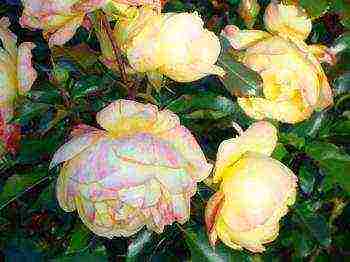
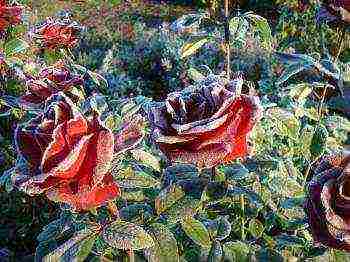
Tatiana Veneaminova Kolchina g.Mound
Siderata in natural agriculture. No-till green manure. Minimum tillage. Mulching. Growing green manure.
Care for plant residues and soil organic matter is the main arsenal of Agriculture. Now they often say that these are the methods of "NATURAL farming", because all agrarians try to call themselves "Farmers", even those engaged in soil-destroying agrochemical agriculture.
Where there is no possibility to apply super-intensive agricultural techniques "of natural type" based on "active mulch" HERE ,or "field composting" agrotechnics HEREFarmers are turning to more affordable options. And we have at our disposal options with growing green manure and minimal tillage.
Minimum tillage and no-till green manure - what is it? How to combine it and use it in practice?
Of course, when you are faced with a significant amount of plant residues from green manure, it is very easy to get scared and doubt….
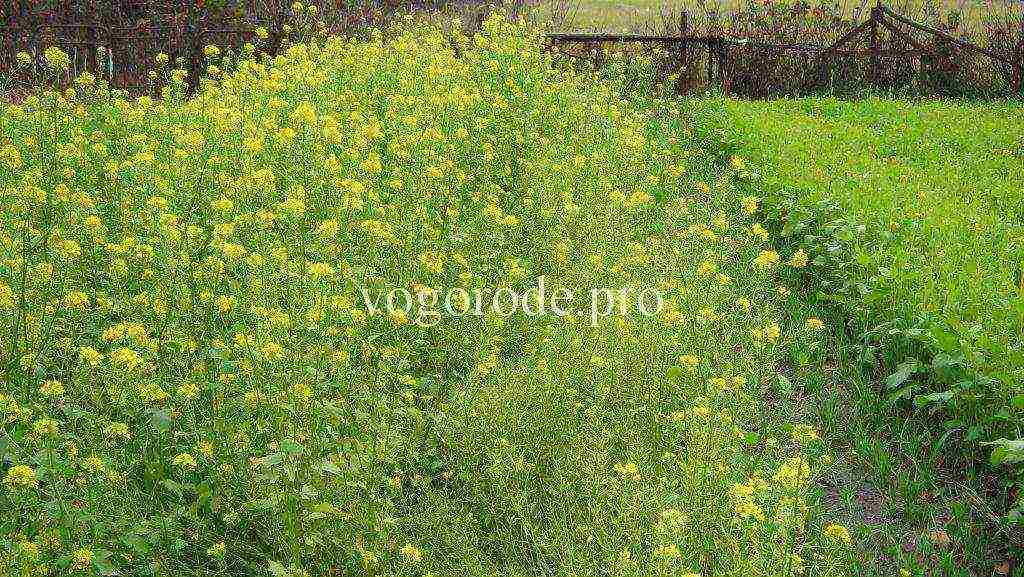 Siderata. Mustard.
Siderata. Mustard.
1 ... If the Earth “spent” its energy on the production of this green wealth, is it possible not to “rob” it without burying it all “back”?
2 ... What is the use of this "wealth" if it is not buried in the ground?
3 .... If you don't have the strength to bury? Mow and burn for "fertilization" - ash? Take it to the compost heap?
I will not hide the fact that when I was stronger than reasonable, I buried such wonderful siderates in the ground.
 Siderata. Winter rye. May.
Siderata. Winter rye. May.
In the May-June heat, along with sweat and many bad words, my love for the traditional digging and plowing agricultural techniques left me.
God did not allow me to bend in hard and harmful to the earth toil, introduced me to an experienced agronomist-farmer. It turned out that the main thing is to let the land work, live, produce, give birth…. And what is born in this life and work cannot be destroyed, destroyed, burned, and rotted. And digging and plowing, our physical labor, which is not natural for living natural systems - no less than fire contribute to the destruction of what our plants and earth produce, give birth to.
Minimum tillage - (no-till) - was developed and described by the Russian Agronomist Yevgeny Ovsinsky in 1906. In his fields, he left only the loosening of the topmost layer of soil, necessary for sowing seeds and keeping the soil from drying out. Such loosening (harrowing), after rain or watering, is used by many today, in vegetable gardens, calling it "DRY WATERING". And many replace this operation mulching.
At the beginning of the 20th century, Ovsinsky's no-till farming technology began to be called the NEW AGRICULTURE SYSTEM, in contrast to the then already developed mineral-arable system, using plows and mineral fertilizers. And at the beginning of the 20th century, without mineral fertilizers, digging up the soil, burying manure and compost into the soil, agronomists-farmers knew how to get the same harvests that agrochemical, mineral-arable agriculture obtains at the beginning of the 21st century.
Productivity in agrochemical agricultural techniques is always ensured by accelerated mineralization, which is accompanied by the disappearance of soil organic matter, and a decrease in the natural fertility of the soil. Decrease in soil fertility and destruction of soil are masked, up to a certain point, by plowing compost, manure, mineral fertilizers and AGROCHEMICAL SITERATION ("green fertilization", burying a huge mass of young green manure in the ground).
In the middle of the 20th century, agronomists appeared in the USSR, who, contrary to the instructions and rules, at their own peril and risk, stopped plowing and burying the grown green manure mass. Organic matter began to form, but it ceased to rapidly decompose - to mineralize. It got the opportunity to accumulate in the soil to its maximum possible. In the Belgorod region, Vitaly Gridchin was involved in this. Most likely, other regions had their own talented farmers. The yield began to grow due to soil formation.
The soil began to recover, and at the same time the yield began to grow. Gridchin, in contrast to agrochemical green manure, introduced no-till.
Gridchin did it in about the same way, both in huge fields and in his own garden, growing siderates, without any plowing and burying them. Tillage to the depth of a rake. Minimum treatment - no turnover, or 5-7 cm. There is also zero treatment. Nothing loosens at all. Direct sowing technology. I'll show you this option using garlic as an example later.
It is extremely important that ANIMAL SIDERATION fits organically into agricultural techniques with minimal tillage. It is the development of Ovsinsky's NEW AGRICULTURE SYSTEM. This is especially true for crops that yield good yields but produce relatively little plant residues. And this is almost all of our garden crops. Next, consider the minimum tillage in large areas - HERE,
Minimal tillage and green manure in small beds - HERE
I will answer your questions in the comments.
Belgorod.
The first step to switching to organic farming is to completely eliminate the use of chemical fertilizers.
Further actions are aimed at improving and restoring soil fertility.
Planting green manure
Sideration is one of the main ways to increase soil fertility in organic farming. Siderata are grown to obtain organic matter, which later serves as a source of nutrition for soil microorganisms. It is microorganisms that make the soil fertile and nourish the plants. Other useful properties of green manure:
- act as live mulch
- increase the activity of beneficial flora
- suppress weed growth
- the bright flowers of some green manure attract insects
- cleanse the soil from pathogenic microorganisms
More about green manure plants
Don't dig!
Deep plowing and digging reduce the activity of natural microorganisms, destroy the structure of the soil and reduce its fertility.
The earth must be loosened no deeper than five centimeters using a homemade flat cutter or Fokin flat cutter. This loosening of the soil is quite enough to prepare the land for planting vegetables, aerate it, and reduce the number of weeds.
The composition and structure of the soil, created by previous plantings, is not destroyed, the activity of worms and microorganisms living in the ground remains the same.
The soil must be mulched
Organic mulch very well saturates the land of the site with minerals that are so necessary for plant growth, and also improves its composition, promotes the reproduction of earthworms and other soil organisms.
The content of vermicompost is gradually increasing in the mulched soil. The covered soil is protected from overheating in the sun, and, accordingly, from rapid evaporation of moisture, hypothermia and erosion. Straw, leaves, sawdust, hay, etc. are suitable as mulch.
Read more: Mulching - why, why and how correctly
Maintain crop rotation
Crop rotation or, simply put, alternation, changing crops, helps maintain soil fertility, significantly reduces the number of diseases and pests.
All annual crops should not grow in the same spot for the second year in a row - this is the simplest crop rotation scheme.
Complex systems include ten-year rotation patterns for vegetable and fruit crops.
You can perform crop rotation according to one of two principles: alternate families or groups of crops (leaf, fruit, root crop) with a minimum change plan (usually three to four years).
Read more about crop rotation at this link
Make warm beds
The beds made directly on the compost heap are still warm - heat is released during the decomposition of organic matter. The temperature of a warm bed is two to four degrees higher than the ambient temperature. This makes it possible to plant plants ahead of time. Direct composting in the beds with raw organic matter provides the following benefits:
- there is no need to distribute the finished compost to the beds
- carbon dioxide is completely used by plants, while its share in the finished compost is significantly lost
- mulch function is performed
- the humidity and temperature of the beds are regulated
Note to the gardener:
Siderata are divided into families: legumes, cruciferous and cereals. Legumes enrich the soil with nitrogen.
These include lupine, vetch, peas, soybeans, lentils, sweet clover, sainfoin, clover, and alfalfa.
Cruciferous plants (mustard, oil radish, rapeseed, rape) saturate it with sulfur and phosphorus.
Grain green manures sprout quickly: wheat, rye, barley, oats, granary. They enrich the soil with potassium and inhibit the growth of weeds.
When sowing green manure, observe the crop rotation, so you will saturate the soil with different microelements.
Eco-farming - Readers' Answers (moved from comments)
I am ready to subscribe to every word of the author, because I think the use of "chemistry" is possible only for flowers and ornamental plants, and in relation to what goes into food, more gentle processing methods should be used.
In the last 3 years, I have been exploring natural farming with interest. We have a training center in Voronezh, where I attend lectures on this topic - very informative! I put a lot of knowledge into practice in my summer cottage.
Blanket for soil
Our summer cottage is located on sandy soil with high acidity, so we have to reduce it. I bring in humus, "chemistry" - the very minimum. My natural farming started with mulching. As soon as the first grass grows in the district in April-May, I begin to create a blanket. Any grass goes into the mulch, but medicinal is preferable.
Around the dacha village is full of nettles, yarrow, wormwood, tansy, celandine, dandelions, burdocks, etc. And various weeds grow in the garden. In the evening, I ride a bicycle to get grass. I cut it with scissors, pack it in big bags, my husband and granddaughter help me. I bring it to the site, lay it out along the edges and in the aisles of strawberry beds, then along the garlic "plantation".
After a day or two, the mulch dries up and settles. I add a new layer, and so on several times. As a result, the mulch layer reaches 5 cm or more. No need to wipe - weeds do not grow through the mulch, moisture remains. Then I mulch other beds with grown plantings. And so all summer. The main thing is to use the herbs before they bloom.
The benefits of mulching are obvious. Over the summer, the mulching layer dries up, rotts and useful humus is formed. There are many more worms in the ground. The soil does not dry out, does not overheat from the heat. In the fall, I embed the rest of the mulch into the soil, preparing it for winter sowing.
Natural dressings
I use mustard as a siderat. Her potato beds are especially fond of. But it is necessary to try other green manure plants. Oil radish and plants of the legume family are highly praised. The main thing is that the earth does not remain bare! because in nature something always grows on it, which means that it needs to provide approximately the same conditions in the garden.
Spring is early today. Already on March 28, I sowed some carrots. When I was preparing the garden, I noticed that there are a lot of worms in the soil. So my land is alive!
And now a little about plant nutrition. I grind the medicinal herb (and just any weeds), fill buckets with it, old flasks. I add humus, mullein, ash, add water, close the lids and put in a cool place for a week. The proportions are all by eye.
When the composition begins to ferment, the smell is very strong and unpleasant, so I remove the containers with feeding further away. And after a week I filter the infusion, throw the plant residues into the compost. After that, I dilute the dressing - 1 liter per 10 liters of water. I water all plantings with this solution. I do this every 2 weeks. At the first feeding, you can also add 1 tbsp. l. urea in a bucket of water for the growth of green mass. And then no artificial additives are needed - only all natural. Effective - tested!
On high
We fell in love with the high beds. We make more and more of them every spring. They are fenced with boards, slate. How to do them - there is a lot of information. All winter I prepare material for these beds. These are cardboard boxes for pizza and pies, newspapers (modern paints in the printing industry are less poisonous than before). I have plastic trays on the radiator under the kitchen window. They dry dormant coffee, tea, eggshells, onion and garlic peels, citrus peels. I tamp the dried material into boxes and take it to the dacha, so as not to litter the apartment. And in the spring I fall asleep in a compost container or on high beds, which in the first year will also be warm (due to the active decay process). I use these beds for planting cucumbers, green crops, Chinese cabbage, early tomatoes, peppers and eggplants.
Little tricks
I even learned to dry potato peelings in an apartment in a shoe box under a kitchen radiator. In the spring, I add dry potato peelings around the currant bushes. Productivity increases markedly, and pests are reduced. But cucumbers, onions and carrots are very fond of drunk tea and coffee. I pour them into the groove and then sow the seeds.
Very often they write that the beds for spring sowing and planting are prepared in the fall. I am not particularly wise on this score. In the fall, I scatter humus over the garden. I pour matured compost under the bushes, flowers and trees. And I do it as late as possible, after the onset of cold weather. I pour it directly onto the grown green manure. So our land, insulated, goes into winter. And in the spring, I loosen the soil early and retain moisture. This is my natural farming.
Organic eco-farming - summer residents share their experience
"Vulgar" summer resident
Everyone has always called my site perfect. And I was proud of it. Kept it almost sterile. Weeds, waste - all in the compost. I dug up the earth both in spring and autumn, removing everything up to the beetle. The beauty. And suddenly I began to notice that my land is slowly beginning to resemble asphalt - after watering and rains, it swam, cracked (photo 1), the harvests did not please. And most of all I was surprised by the disappearance of worms: the main thing is that the neighbors have, and I have none. And until then I was at a loss, until I came across a book on organic farming. It was then that my eyes opened - removing all the organic matter from the site, I simply starved my worms to death. And digging up the earth with manic persistence in spring and autumn, I also destroyed the beneficial microorganisms living in its different layers.
Dear summer residents, do not do as I do! One harm from such purity. For my own breadwinner, the land, I was more terrible than a fierce stepmother.
And for five years now, I have been behaving exactly the opposite. Now, from all nearby landfills, I carry to my site and weeds, and mowed lawn grass, and vegetable waste (I do not take only tomato and potato tops). I cover the beds and the passages between them with all this goodness. I also periodically water them with a solution of fertilizer based on humus and diluted tincture of fermented grass {1 liter per 1 bucket of water). These tools serve a dual purpose. Firstly, a good feeding, and secondly, the process of decomposition of biomass is accelerated. My vegetables really like this mulch, and the underground inhabitants are happy and well fed.
Since about August, I have not laid out anything on the beds - I will not have time to overheat. Instead, I start filling the compost heap.
Actually, I have two of them, I use them one by one: I hammer one, the other, ready from last year, I “unpack”. We have a large park area next to the dachas, so I put a large amount of foliage in the compost, sprinkling it with earth and vegetable waste, there are also a lot of them in landfills in the fall.
Once a familiar summer resident, seeing me carrying this "product", snorted: "Fu, how vulgar!" And I want to shout: "Long live the landfills!" Well, where else can you get so much organic matter? One's own is a drop in the ocean. Don't judge me, I actually benefit from them.
Organic cycle
The second remedy for my depleted soil was green manure. I don't dig the earth now. As soon as a bed is free, I, without removing the half-ripe mulch, scatter the seeds of the plants and cover them with a hoe. If it's dry, be sure to water it - this way the grass will grow faster and grow more green mass. Once I sowed rapeseed in two plots: in the near one I watered the seeds, in the far one I was too lazy. As a result, on the first, everything was thickly overgrown, on the second - barely. And if not for such a comparison, I would have shouted that I was sold low-quality seed.
I sow mustard in a bed for garlic, and when the time comes for planting its neighbor, it already has time to grow by 10-15 cm. Then I make holes with a peg right along it and throw garlic cloves into them, filling them with compost. With this planting, 80% of the mustard continues to grow (as seen in photo 2). With the onset of cold weather, I fall asleep this bed with foliage. In early spring, I leave everything in the same form: under the weight of the snow, the foliage will settle, and the garlic will easily pass through it. But since the ground under the leaves does not immediately warm up, the plants sprout a little later than those of their neighbors. True, this does not affect the harvest, but weeds do not grow under such mulch. Sometimes I water it, and by the fall, almost all the foliage is melting, and my garlic is beautiful (photo 3)!
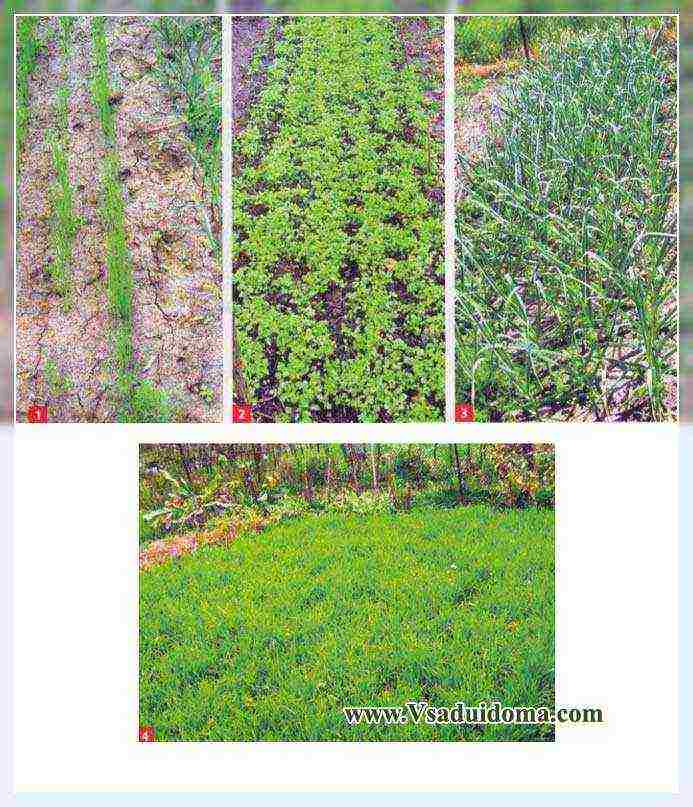
After harvesting it (in mid-July), I plant sprouted potatoes on this bed. Last year, on October 19, frost hit and killed the tops. But I dug almost a bucket of potatoes the size of a chicken egg. Such "youth" is good for planting - the variety rejuvenates.
After harvesting the main potatoes, I cut shallow grooves and sow rye. Having pierced it with a rake, I water it. In winter, the plot leaves with a green carpet (photo 4).
Another secret: after removing the early vegetables, I sow the plots twice. First, I sow fast-growing phacelia and mustard. In September, I chop their juicy greens with a shovel right on the spot, knocking them to the ground with my foot. After that I cut the "pancake" of the ground with chopped grass and turn it over. And after that I sow winter rape or rye there and close it up with a hoe. Be sure to water it if it's dry. And the grown greens hold back the snow.
In spring, rapeseed and rye continue to grow green mass. A week before planting any crop, I again chop the greens and turn the earthen "pancake". And where the phacelia and mustard have gone in the winter, as soon as the snow melts, I scatter mustard over the phacelia, and phacelia over the mustard. The land at this time is still damp, and green manure grows up to the main plantings. Directly along them, I cut furrows for onions, dig holes for tomatoes and peppers and pour compost and ash into them.
Siderata and vegetables grow together until waste ends up in landfills. Then I prune the siderata, leaving them in place, and cover them with waste. And then - read first. Here is my cycle in the garden. The main thing is not to uproot the green manure. The more dead roots remain in the soil, the more porous it becomes. I even leave the root systems of tomatoes, peppers, cabbage and flowers before winter. A beard made of small roots is processed by worms during the winter, and a large part can be easily pulled out of the ground in spring. And now I will summarize.
You won't be able to beat your thumbs
- Mustard. It rises and grows quickly, heals the soil, the wireworm does not like it, it attracts bees, only it is not necessary to sow it thickly, otherwise there will be no fluffy green mass.
- Winter rape. Increases fertility no worse than manure, prevents the growth of weeds, enriches the soil with phosphorus and sulfur. You need to chop before flowering, otherwise it will become very tough.
- Rye. It fluffs up the soil very well, enriches it with potassium and nitrogen, inhibits weeds. It is not worth planting in one place annually, because a wireworm may start.
- Phacelia. It is unpretentious, grows quickly and decomposes in the soil, it suppresses weeds best of all, expels wireworms, withstands frosts down to -7 °. Blooms for almost a month, honey aroma. The bees are just crazy about her, which is important for all cultures blooming in the country.When the seeds begin to form, I sometimes cut it off and put it in the place I need, where it crumbles and begins to grow again.
- Beans and peas. I also sow the surplus of these legumes, like green manure. They enrich the soil with nitrogen. Peas can be sown immediately after the snow melts, and beans are thermophilic.
These are my observations. And since I carry out all the work at an accelerated pace (thanks to the same landfills and the park area), I can boast. Now I have a lot of worms - large, fat ones, my soul rejoices looking at them. The land has improved markedly. The top layer is grainy, even darker in color. And the harvests are pleasing.
That is why, remembering myself, completely inexperienced in a new business, unable even to sow green manure correctly and at the right time, I decided to share my experience.
By the way, I disagree with those who consider organic farming to be an easy job. Not digging is only a quarter of the deal.
You need a lot of mulch. Need sowing siderates, embedding them in the soil, etc. It seems to me that someone who does not actually do it speaks about ease. I wish you all great harvests.
Organic harvests
We are for organic farming, and our goal is to obtain an environmentally friendly harvest. Therefore, we try to select natural fertilizers and means of protection against pests and diseases.
Squash abundance
We do preventive treatments for diseases at least twice a month. We alternate between different drugs. We use exclusively biological fungicides: Fitosporin, Fitop-Florz-S, Alirin, Gamair (mix the last two after dilution according to the instructions). They contain beneficial bacteria that prevent the development of pathogenic microflora. We use it right away, because working solutions prepared on the basis of beneficial bacteria cannot be stored. If it rains, repeat the spraying. We feed the plants with a “cocktail”: in a solution of chicken manure (1:20) or vermicompost we add soft humin potassium fertilizer diluted according to the instructions (zucchini especially needs potassium at the time of fruit filling).
Despite all the efforts, at the end of July, the initial signs of powdery mildew were noticed on the bush of the new Patio Star variety. To prevent its further development, the plant was sprayed with an anti-stress drug Stimul and every 10 days for prevention it was treated with fungicides.
Of the new products this year, I especially liked the Portioned zucchini variety. Many people are familiar with the situation when, during cooking, large zucchini fruits do not go away entirely and then often wither in the refrigerator. But the Portioned zucchini got its name for its compact size - it is a fruit at a time. In addition, it is very fruitful and disease resistant. In our opinion, he still has a drawback - he lets out long whips, but we did not pinch them.
And not only blue ones
We grow eggplants of different varieties and hybrids - this is much more interesting.
We feed them (usually at least twice a month) with the same "cocktail", spray them with any anti-stress drug {Ecogel, Zircon, Narcissus, Stimul, Eco-pin - they can be used on all crops twice a month, alternating root and foliar processing) and add Fitoverm for prophylaxis, because eggplants are often damaged by spider mites. Such feeding is especially important during the fruiting period. We regularly carry out "green" operations: we clean the trunks of stepchildren, form plants in three stems. We do not delay the harvest, because the more often we remove the fruits, the more they will be tied up. Now, at the end of August,
when the nights become cold and excess moisture contributes to the development of fungi and bacteria, we intensify the care, because if you do not take action, the eggplants will start to hurt. Spraying with biological fungicides began to be done weekly, and the beds with plants were covered with white non-woven material.
Tomatoes until autumn
When tomatoes ripen en masse in the greenhouse, many summer residents lose their vigilance, because here it is, the coveted harvest, just have time to collect it.But, if you want to extend fruiting until late autumn, continue to regularly care for the plants. Since August, we weekly treat bushes for diseases with any biological fungicide, alternating root and foliar treatments. Twice a month we spray the tomatoes with an antistress drug. During the ripening of the fruits, the need for potassium increases sharply. Therefore, once at the root, pour the tomatoes with ash infusion. Once a week we fertilize the plants with the already known "cocktail", but at this time we dilute the chicken droppings instead of 1:20 1:60 in order to minimize the nitrogen rate, but we give potassium according to the instructions for the preparation.
Transforming the earth through "organic" methods
I also want to tell you how I came to organic farming and how my land was completely transformed in three years. I live in a village - a house and 27 acres of land: 24 next to the house (the land here is light, soddy-podzolic), and 3 acres separately, 300 meters away, under a steep hill, where there is heavy loam. Previously, when they plowed with a horse, they made the beds immediately, and the earth did not have time to dry out. Four years ago, she asked me to plow a garden and cut the combs by Saturday (by connecting two combs together, we get a garden bed).
The owner of the tractor, due to circumstances, plowed up on Tuesday. In clear weather and a temperature of 20 ° by Saturday, all the ridges turned into large hard blocks of clay. How do you break them? It is a pity to break the flat cutter, the teeth of the garden forks have broken off. There is nothing to say about arms and back ... It would have been much easier to dig up with a shovel, but - what is done is done. Remembering all the obscene words known to me, I said that the tractor would not drive into my garden anymore.
Wheatgrass, nettles, and spurge climb from the border through the furrow into the beds. It is much easier to harvest them with a hand cultivator than with a flat cutter or a pitchfork. I used a shovel only for tamping the edges of the ridges, and now I have stopped doing this. I will form the beds with a flat cutter, raking the ground from the furrows, and so I leave the edges loose. Somehow, during work, I did not notice, but climbing the hillock, I felt that my back did not hurt! Tired of the habit of forearms, and even then because the ground in the first year was very dense. I immediately advertised the hand cultivator to everyone I knew: for a sore back, this is just a godsend! You only need to bend down for the roots of weeds, but every year there are less and less of them.
In general, I made a bed, planted everything. In August, having removed the onions, she sowed mustard and oats. And after removing the carrots, beets, radishes and cabbage, I left the whole leaf in place - so everything went under the snow. In the spring there was a little mustard straw and cabbage cuttings on the garden bed, everything else was eaten. When I pulled out cabbage stumps (and in spring they are easy to get), earthworms swarmed on the roots, and not one at a time, but in heaps of several.
I plowed the garden bed with a cultivator right with the straw. The ground became softer, the teeth easily entered the soil without much effort, and I did it much faster than in the previous year. In the summer, she sowed oats and mustard again and again left everything under the snow. And by the third spring, the earth was already so soft and loose that there was no point in loosening it! With a flat cutter, like a hoe, I lightly chopped the mustard straw, cut the weeds in the furrows - and that's it, the bed is ready.
The soil on the cut resembles a sponge, porous. I have never seen such a number of worms in the beds, except perhaps under a pile of manure. There is no crust, no swollen earth. The plot dried out very quickly, although there is a swamp nearby. I have not applied manure for more than three years, but soil fertility does not decrease - on the contrary! From a planted bucket of onions (family), 8-10 (!) Buckets grow, and carrots and beets have only one drawback - they are too large. Cabbage heads did not fit into the bag this year, and it is rather big - from the feed.
I confess right away: I don't pamper my plants with special care. I never water onions, carrots, beets. Cabbage is only in the holes when planting, and I cover it with dry earth on top.
Only tomatoes and cucumbers in the greenhouse receive liquid feed from me.In the open field, I water only cucumbers (the garden bed is covered from above on the soil with a film or black spunbond) and young apple trees. The rest all survives on its own. I cover tomatoes, zucchini with mown grass, strawberries with newspapers, and on top with a thin layer of sawdust. By the way, this is what saved her from freezing in the snowless autumn of 2014, when frosts hit -17 °. All the strawberries of the neighbors were frozen.
The maturation of compost is a long process. In addition, during the winter, the contents of a box or pit freeze and thaw rather late - somewhere in the middle of May. To speed things up, pour plenty of warm water over the compost, but never boiling water! If you need to urgently defrost the compost, sprinkle it with ash on top and sprinkle it with hot water three times a day. Cover with plastic wrap or burlap overnight.
Neither thick nor empty
I would also like to tell you how I grow vegetables. The bed is long, more than 30 m. After loosening with a flat cutter or a cultivator, I have it even, loose. I do not level it with a rake - with a flat cutter or a rail I draw grooves along the ridge. The first one - closer to the edge, stepping back 3-4 cm. I sow carrots into it, not thickly, with a seeder, after 3-4 cm. If two seeds fall somewhere, I leave it: it will not grow so huge. After stepping back 30 cm, I make the next groove, then two more after 25-30 cm. I pour a little ash into them and plant onions.
The distance between the bulbs is 15 cm, if small, and 20-25 cm, if large. I plant sevok in the extreme groove. The bed is wide, but I weed it, loosening it with a small flat cutter on a long handle. I leave the grass in place: it will dry out very quickly, single stalks take root (I will remove them during the next weeding before lodging the feather). When the onion begins to turn yellow, somewhere in the first ten days of June, in rainy weather, sprinkle with salt (not thick). If the tips of the feathers turn yellow strongly, you can add a little urea to the salt - the feathers begin to grow actively.
I clean it when the neck dries up, and the sevok - when it falls. And immediately I sow mustard and oats. With a flat cutter I make grooves, scatter the seeds, level them: if you sow on top and fence them with a rake, the birds will peck out. I pre-soak the oats. Carrots and sets remain in the garden. Between the sevka bulbs I throw mustard seeds, they sprout, grow and by the time of harvesting the onions reach a height of 15-20 cm. In September they grow even more.
Along the furrow where the sevok grows, I sow beets with seeds. Also not a lot: where it will rise in two or three, I leave it - the roots will not be so large. I prefer varieties with small tops, such as Detroit, Pablo - they have a thin skin, no ringiness, sweet, juicy. I also sow radish in the furrow - it grows better than in the garden. I plant cabbage from one end of the garden, alternating with onions after a year, and I swap carrots with onions.
Where green manure is not sown, I leave the tops of vegetables for the winter. Under the cabbage in the holes I put half a handful of dolomite flour, a pinch of superphosphate, a little ash. I water and plant seedlings in the mud. Sprinkle on top with dry earth, and that's it - there will be no more watering. But from the cruciferous flea, you will have to process it. And some of the chemicals: ash does not help. Countless hordes attack and instantly suck the juices from the delicate leaves of the core.
Salad onions, problem-free
That's how I build my own garden. The longest work is weeding in the carrot row, where I pick the blades of grass with my hands. I don't get close to the plants with a flat cutter, so that the carrot does not grow horny.
I do not process anything from carrot and onion flies, worm-eaten carrots do not exist, and several nests of onions can be affected, but this is a drop in the sea.
In addition to family onions and sets, I have been planting Exibishen salad onions for several years now. I sow seeds on March 8-12 in half-liter tall plastic containers or plastic cups 0.5 liters. I sow in 1-2 cm from each other, it is better to see them in the snow, and I sprinkle it with earth. I put it in a dark place before germination. When the loops appear, I remove the lid from the container and put it on the windowsill. I plant it in the garden around May 9th.I look at the forecast so that there will be no frosts in the coming days - then they are no longer scary.
I make grooves, water abundantly and spread the roots in the mud. I try not to deeply deepen the onions that are from a match head. If the weather is hot, I water it several times. The care is usual - weeding, loosening, the bed is well fertilized, so I do not feed it with anything. I clean it in September, when the neck becomes soft and the feather becomes soft.
The bulbs grow up to 600 g. There is only one drawback: you need to eat everything in three months - the onion is so juicy that it cannot be stored for a long time. What we do not have time to eat, I distribute to friends. Even the grandson, when he was three years old, asked: "Yuba, give yuka!" (he has not yet pronounced the letter "L"). And he ate it raw, to the horror of his mother, who does not eat onions at all.
I strongly advise all summer residents to grow Exibishen. The fly does not touch him, there is no hassle with him, only you need to spend a little more time on landing than on sevok, and that's it.
Please note: dishes for onion seedlings should not be too shallow, the depth is at least 10-12 cm. When planting, you can trim the roots and feathers, although you can not do this, it still grows perfectly. But it is better to buy good seeds. All the years I have been buying Dutch ones: the germination is excellent. But this year I somehow watched and bought it in a simple white bag. It has not grown at all! It seems to taste and similar, but the onion itself is not so large, and the color of the integumentary scales is darker.
Good luck and good harvests to all summer residents! Many thanks to everyone who takes the time to share their experience. Now I rarely write, and if you can make out my scribbles, I will be glad. I do a lot in the garden differently from everyone else in the village. In whatever ways I planted potatoes, and I really love them, what varieties I have tried - do not count! But the results are always encouraging.
And now my wish to all summer residents: do not be afraid to part with a shovel! It is not necessary to load tons of land for free, take pity on the land, and your hands, and your back. I only use a shovel for digging planting holes under trees, and, as you can see, nothing terrible happened: the harvests do not decrease.
Below are other entries on the topic "Cottage and garden - do it yourself"
Early potatoes in the Tula region: Tula early potatoes: by trial method ... Peony flowers - propagation by layering: Peonies - by layering Last fall ... Fighting onion fly - ... What are spur varieties ?: Spura varieties of apple and pear ... Growing cucumbers for many years in one place: Crop rotation and cucumbers So, my own story ... Do I need to alternate plantings after green manure?
Subscribe to updates in our groups.
Let's be friends!
Other entries about natural farming
Digging the soil is a traditional occupation of gardeners in autumn and spring. This is a difficult matter, it takes a lot of energy. Do you need to dig, does it benefit the land and plants? Let's figure it out ... What is "digging" and "plowing" Let's start with dictionaries. Here…
About 5 years ago, when the youngest grandson was four years old, and the middle one was in first grade, the children helped me take care of the plants in the garden. "Kill! - shouted the youngest, referring to the elder. - This is a harmful stinker! " But the first grader was in no hurry. He…
I want to master natural farming on virgin land - now, in spring. Where to begin? To dig or not to dig? Weeds and wild grass to remove or poison?
When the most difficult work on the site ends - all the beds have been dug up, the first weeding has been carried out - the gardeners sigh with relief. What remains? The joy of a job done on time, the first greens on the table and fatigue. It's time to think ...
Today we will talk about how gardeners themselves prevent nature from growing a rich harvest on their own plots. The desire to get a good harvest pushes most people to seek new farming methods. Moreover, all ...
I am a beginner gardener, only for the second season I will work on my site myself. And last year, when they bought a house, I immediately wondered: how many tomatoes should be planted for one family? It is from this question and the subsequent articles of Nikolai ...
See all materials
about natural farming :
See all


